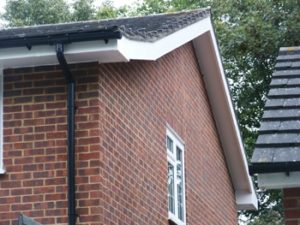It's The One Fascia And Soffits Replacement Near Me Trick Every Person…
페이지 정보

본문
 Soffit and Fascia Replacement Near Me
Soffit and Fascia Replacement Near MeSoffits are vital for the health of your house. They keep away mold, rot, and pests. They also provide ventilation to your attic. They give your roofline a beautiful appearance.
Repair any damaged soffit and fascia immediately. Be aware of indications of discoloration or chew marks.
Damaged or Deteriorated
The performance and appearance of your home's fascia are important, regardless of whether it's made from aluminum, wood or vinyl. They give a finished appearance to roof overhangs. They also draw air and moisture out of the attic and protect the wood trim below and the roofing beneath from weather-related damage. Over time, they can be damaged or degraded and cause damage to your home's roof and.
A damaged or deteriorated soffit or fascia can lead to various problems, such as the infiltration of water and the growth of mold. The damage can also weaken the structure of your roof and can affect your home's structural integrity. Rodents and pests can also gain access to the attic where they can cause damage or build nests.
There are several professionals who can perform soffit and fascia repair such as roofers, gutter specialists, and carpenters. When searching for a pro, be sure to ask about their work experience and background. Finding a trustworthy professional, licensed, and experienced professional is the best way to make sure that your soffit and fascia are installed and repaired correctly.
Fascias and soffits aren't ideal DIY projects for homeowners because they require working from either a ladder or the roof. The tasks can be complicated and climbing a ladder can be inherently dangerous. Furthermore, most homeowners lack the knowledge and tools needed to accomplish these tasks. Hiring a professional can help make sure the job is completed correctly and that your fascia and soffit are able to endure the elements for a long time.
Cracks, gaps and discoloration are all signs that your fascia and soffit require to be fixed. Check them regularly to look for these issues, as well as rot or insect infestations. Examining your fascia and soffit can be easy, as it is often visible from a distance. You can also check for droppings, gnaw marks and nesting materials, which are indicators of pest and rodent activity. If you spot any of these issues, call a professional to schedule repairs to fascia and soffit as soon as possible.
Infestations
Soffits and fascia help protect your roofline from water damage. Soffits are located at bottom of the roof's overhang. They are used to ventilate your attic, drain water from the home and keep pests out. Like any other component of a roofing system, they are not immune to wear and tear or environmental issues. They're also susceptible to insect infestations, and if you observe telltale signs of infestation, it's crucial to have your fascia and soffit repaired as soon as is possible.
The main function of fascias & soffits is to guard the roof's edge from elements and to direct rainwater down and away from your eaves and foundation. It also supports gutter installation and serves as an anchor point for downspouts. It's also normal for wood fascia to be damaged by water if gaps or cracks are left untreated, but professionals can close these holes to stop water from leaking in and damaging the structure.
Infestations in fascias & soffits and soffits are typically caused by poor maintenance, but can be caused by animal or rodent activity, weather exposure, or physical damage. Birds, squirrels and raccoons are likely to build nests in these structures if they are damp or rotting. Infestations can be caused by a lack of cleaning, such as using pressure washers that are too close to your roofline.
If your fascia is swarming with mold is it time to call a professional. Mould is toxic to human health, and can cause serious respiratory and cardiovascular problems in the event that it isn't removed completely. A professional can safely eliminate and treat mold to ensure that it doesn't return and cause further damage to your roofline and interior.
The stains on your fascia soffit guttering that are caused by water are another sign that it's time to schedule an inspection. This issue is typically caused by an unvented roof that allows moisture to enter the attic. When cool attic air isn't able to escape, it will get trapped in the eaves, and cause mildew and moisture issues, or even a roof leak. A professional roofing contractor with experience can help you determine whether this is the case.
Asbestos
Soffits and flanges may appear to be straightforward architectural elements that provide the roof structure of your house a polished and clean look however, these essential elements do more than enhance its aesthetics. These crucial components of your roofline are vital for keeping your home comfortable and dry. They also help prevent the development of serious mould and damp damage.
If your roofline is old it may be filled with asbestos, a carcinogen that was commonly used in construction materials, homes and other products until the end of the 1980s. If your soffit or fascia boards are made from asbestos, it's vital to get them tested by a professional prior to any work to the roofline is carried out. This is because asbestos can be dangerous when it is cut or broken, or disturbed, and the tiny fibres that can be inhaled escape into the air.
If you're worried that the soffits and fascia repairs near me on your roof are made of asbestos, it might be a good idea to set up a temporary scaffolding in order to ensure the safety of anyone working on your roof. This is because it's a legal requirement of care to ensure that anyone working on your property has the required level of safety knowledge and training.
Asbestos cement soffit boards can be difficult to identify, as they're painted to blend with the rest of your home. However, if you see signs of rust and wear on the surface or notice that the wood is rotting or sliding, it's likely your soffit is made of asbestos cement.
While PVC typically covers any hairline cracks or flaws, asbestos-laced soffits are much more dangerous, as one airborne fiber can cause serious illnesses such as mesothelioma which is a rare type of cancer that affects the lung lining and chest cavity. This is why it's important to have any asbestos-laced soffits and fascia checked and removed by trained professionals before you get your roofline replaced. This is a complicated task that requires extensive testing and decontamination, so it's best left to professionals. Asbestos is a major health risk, even if the building is in good condition. Therefore, it's important to have any damaged or old trim removed and checked.
Water Damage
The soffit, or fascia, is a protective barrier that directs rainwater away from the roofline to the foundation. It also supports gutter installations and serves as anchor points for other elements such as downspouts. It helps prevent water damage by absorbing moisture that could otherwise cause structural issues in a home. It also helps to control humidity levels and maintain warm homes by sealing the attic.
The rotting and moldy timber could affect the fascia. You can spot these issues by observing dark spots or discoloration, or a spongy texture on the surface of the soffit. These issues are likely to get worse over time, so it is important to have them checked and repaired immediately if you notice a need to.
Cracks or dents are indications of a failing fascia. They can be fixed or replaced by a professional. Pest infestations can also be caused by damaged fascia or soffits. Rodents, birds and squirrels are attracted to holes in the soffits or fascia of a house. Once inside, they can chew through insulation and wiring as well as leave excrement which poses health risks for the people who live there.
In the end the condition of a soffit and fascia can have a significant impact on the structure of a house and its value. A home with fascia and soffit that are susceptible to water damage will be prone to decay and mold, mildew, insect infestations and other serious issues that could cause costly repairs and replacements.
A soffit or fascia can be made of aluminum, vinyl, wood or any other material. The kind of material used will affect the length of time the boards will last and how much it will cost to repair or replace them. Wood fascia boards are typically the most affordable, but they require regular maintenance to ensure their appearance. Aluminum, vinyl and composite soffits tend to be more durable than wood and less susceptible to weathering. These options may be more expensive than the traditional wooden option.

- 이전글8 Courses About Alt Sex Stories That you Ought to Examine To Succeed 24.11.22
- 다음글The Best Adult Male Toys Tricks To Change Your Life 24.11.22
댓글목록
등록된 댓글이 없습니다.

